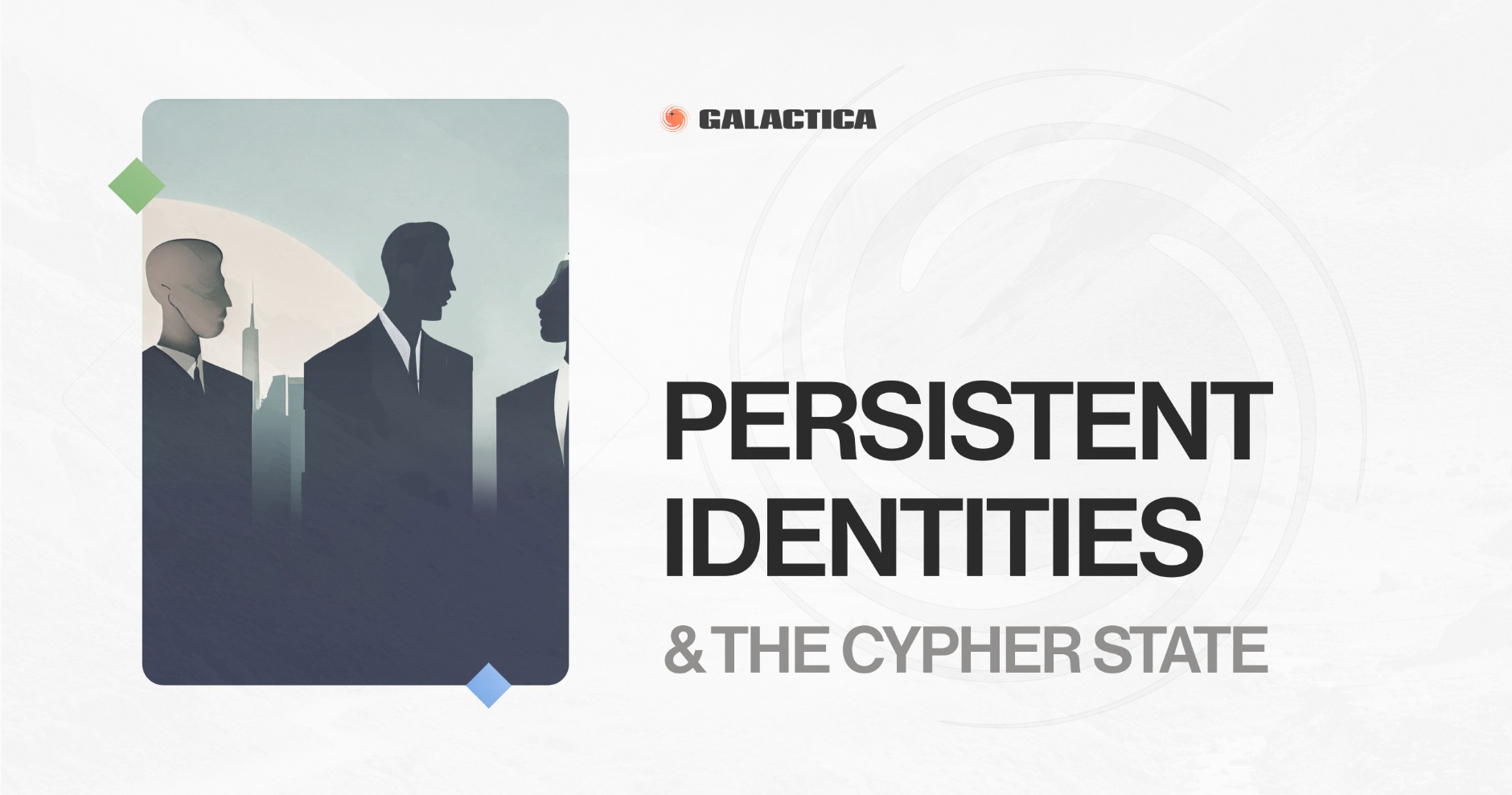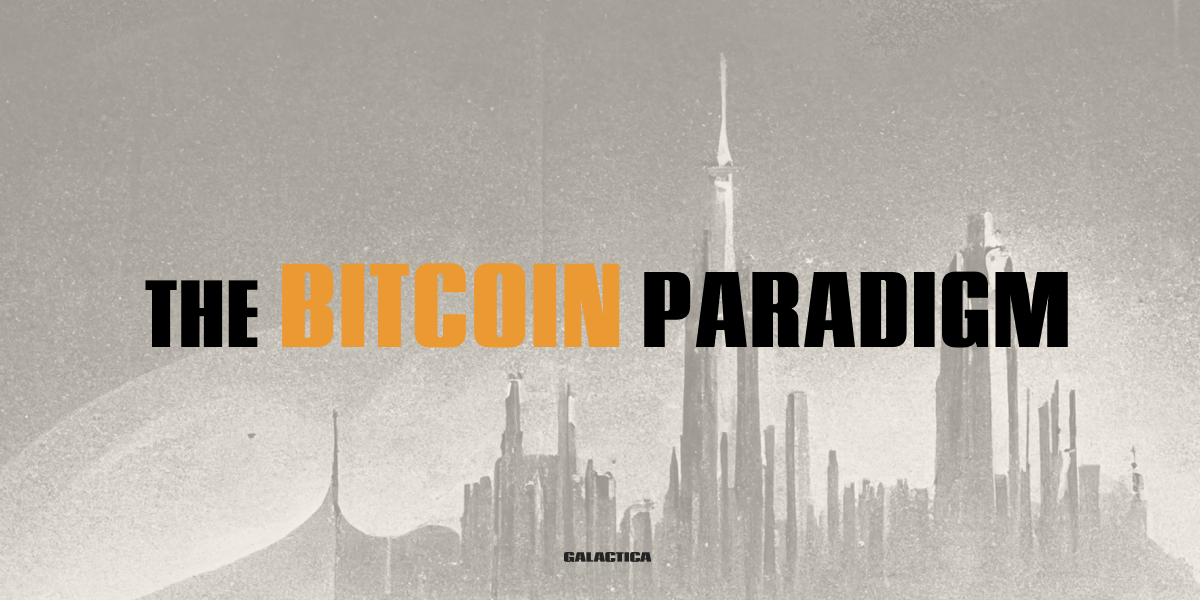

Persistent Identities and the Cypher State
Sybil resistance of a protocol enables complex societal concepts to be meaningfully represented on-chain. Arguably, the most important societal construct defining the most meaningful and rich set of a person's rights and responsibilities is the citizenship. A protocol sufficiently feature rich to instill meaning into the concept of on-chain citizenship can be called a Cypher State. Galactica Network is first and foremost, a Cypher State.

The Bitcoin Paradigm
Bitcoin is a trustless, decentralized protocol capable of settling transactions using a monetary unit with infinite divisibility, that is outside of the control of any jurisdiction, having deterministic monetary policy that makes it scarce and, ultimately, deflationary over time. Reflecting the ideas of the Austrian school in its design and challenging the Keynesian dogma of monetary interventionism, the genesis of Bitcoin has marked the beginning of one of the boldest experiments in human history - that of creating an alternative to the fiat world order.
 Before long, disparate people arrived at the idea that an independent transactional ecosystem has the potential to not only disintermediate the global settlement infrastructure, but ultimately disrupt the very foundations of the global political status quo. Power and capital distributions on a global scale are neatly intertwined, and both require the ability to control the monetary apparatus.
Before long, disparate people arrived at the idea that an independent transactional ecosystem has the potential to not only disintermediate the global settlement infrastructure, but ultimately disrupt the very foundations of the global political status quo. Power and capital distributions on a global scale are neatly intertwined, and both require the ability to control the monetary apparatus.
In less than a decade since the genesis block, bitcoin has become the big idea, and the beating heart of financial counter culture.
There has been a problem, however, that any contingent transactional logic using Bitcoin required centralized intermediaries - exchange, banking, insurance and the entire plethora of other financial institutions and instruments offered in the traditional financial system could not be replicated or utilized purely within the realm of the Bitcoin protocol. No ledger can have meaning in isolation, and so there came demand for intermediaries starting with those enabling the most essential functions of escrow and price discovery, eventually ballooning into a system of intermediaries somewhat resembling those powering the fiat-fueled global financial system.
Exchanges were the trailblazers. Run on centralized servers; cryptocurrency exchanges have, in principle, contradicted the very ethos of Bitcoin, however, this has not prevented them flourishing in the decade since Bitcoin's genesis block.
And then came Ethereum, and with it the inevitable emergence of DeFi.
The Ethereum Paradigm
 Upon the integration of a Turing complete virtual machine directly into the heart of the protocol, there came Ethereum, and with it, the ability to program arbitrary transactional logic disrupting the centralized intermediaries that had been dominating the cryptocurrency space.
Upon the integration of a Turing complete virtual machine directly into the heart of the protocol, there came Ethereum, and with it, the ability to program arbitrary transactional logic disrupting the centralized intermediaries that had been dominating the cryptocurrency space.
With Ethereum, blockchain's range of applications has transcended that of pure cash and p2p transactions. The key output of Ethereum's immense innovation is the value chain of programmable digital money and composable open-source finance.
The applications of Ethereum's smart contracts are many and varied, however, for the purposes of this article we shall focus on the two most notable ones:
a. Financial instruments: DeFi primitives: a vault, an option, a pool, a liquidity token, etc.,
b. Economic and financial institutions: DeFi applications composed of the primitives and custom additional logic. Replicating and transcending the economic fabric that keeps the world turning, Ethereum's economic and financial institutions are lending/borrowing protocols, DEX's, yield optimizers, you name it.
The ability to program custom instruments and institutions has enabled us to imagine a new global financial system: transparent and open-source, democratic and inclusive, one that would exist entirely on-chain creating alternative wealth distribution profiles and ultimately prosperity for billions of people around the world. At least that was the narrative, and without doubt, many would argue Ethereum has lived up to these lofty goals to a far greater extent than many would have expected.
Today Ethereum remains the most vibrant blockchain ecosystem with arguably the most ambitious and far reaching use cases in the space, and by far the fastest pace of innovation. Other entrants into the space have mostly limited their attempts to challenging the technological design of Ethereum in an effort to capture some of its market share.
Our thesis is that these efforts may simply be misguided - rather than challenging the technological foundation of Ethereum, the next wave of protocols should expand the very societal fabrique that blockchain protocols are capable of representing.
The Cypher State

Societal Substrate and Sybil Resistance
'Today's societal building blocks (e.g. families, societies, social clubs, celebrities, governors, governess, employees, employers, etc) have proven to be challenging to transcribe into the virtual space (even more so for blockchains) without a primitive or a set thereof that would represent people themselves and the vast number of mutual relationships by which they are interconnected.'[1]
Protocol's Sybil resistance are mechanisms enabling direct mapping between real world persons and internet identities.
Web2 applications solved the problem of Sybil resistance by collecting users' personal data, and imposing draconian compliance standards. An obvious requirement to impose such standards is having access to users' data (that conveniently can be monetized and as such is the critical resource of the data economy and the fuel of bigtech business models). Thus, Web2 Sybil resistance came at the expense of extreme centralization and virtual elimination of users' privacy.
Most contemporary Web3 protocols record transactions in a pseudonymous fashion; anyone with an internet connection can create an infinite number of wallets on virtually any blockchain. People cannot be modeled on-chain. Pseudonymous by design, Web3 is fundamentally unable to model non-trivial societal primitives: celebrities, families, employers, experts, diplomats and ambassadors, criminals and citizens are all meaningless on-chain as a result.
We come to a very important argument, and, so, want to summarize the last two paragraphs, highlighting the core idea: Web2 has sacrificed privacy on the altar of Sybil resistance, somewhat incentivized by the rents extracted from the data economy. Web3 has done the exact opposite. In the case of Web2, the cost is digital dictatorship, censorship and adverse status quo we all know too well from our everyday experience. In the case of Web3, the cost has been the drastically reduced complexity of societal substrate that could be modeled on-chain. People cannot be modeled on-chain.
But if such representation came into being, what would we call it and what would be the implications? In what follows we will try to demonstrate that this rabbit hole is far deeper than it initially lets on.
Persistent identities and Web3 footprint
First, let us introduce some important definitions:
a. Following the notation established in a better article, a human in the blockchain space could be referred to as a Persistent Identity.
b. The multitude of interactions between any such identity and the rest of the protocol could then be called one's Web3 footprint.
Let's unpack the relationships between the two. In this context, 'persistent' means that a protocol representation of a human, the private key, corresponds to a real world person or identity and that such on-chain identities are costly to duplicate and this cost increases over time. But why would the cost increase in time? It is one's Web3 footprint that would define this on-chain identity and naturally, this footprint increases in size and complexity as the time passes making it harder to replicate or tamper with.
Is there a more intuitive way to define the Web3 footprint? Perhaps bring it closer to something familiar from the off-chain world?
There is, and it's the concept of reputation that is semantically closest in our view.
Let us reiterate: the Persistent Identity is defined by its Web3 footprint - the relationships between an account, other accounts and the system itself. Through one's Web3 footprint, users' impact on the network can be quantified by other users, thus defining a virtual correspondence to real-world concept of reputation.
Protocol's Sybil resistance, Persistent Identities and Web3 footprint together enable non-trivial societal institutions to exist entirely on-chain - in a similar fashion to how EVM's arbitrary transactional logic enabled the emergence of economic institutions in what's today known as DeFi.
Citizenship and the Cypher State
Sybil resistance of a protocol enables complex societal concepts to be meaningfully represented on-chain. Arguably, the most important societal construct defining the most meaningful and rich set of a person's rights and responsibilities is citizenship. A protocol sufficiently feature rich to instill meaning into the concept of on-chain citizenship can be called a Cypher State. At least this is one of the definitions.
Galactica Network is first and foremost, a Cypher State.






